During the late evening hours of December 31st, hopes are high and magic seems to fill the air. Whether we are attending a lively New Year’s Eve party or cuddled up quietly on our living room couch, the sense of wonder for the year ahead permeates our thoughts. What will this next year bring forth?
No matter where we are on New Year’s Eve, chances are that the Times Square ball drop is on some screen in the background. It’s a long-held tradition to stay up until midnight to watch that illuminated ball transcend down One Times Square, officially bringing in the new year.
But how did this tradition come to be? Why do we plan our entire night around this event? It all started with the expansion of a popular newspaper.
In the early 20th century, The New York Times moved its headquarters to the newly constructed Times Tower in Longacre Square. Adolph Ochs, the owner of the newspaper at the time, persuaded the city to rename the area surrounding the new headquarters from Longacre Square to Times Square. That’s right, Times Square is named after the newspaper and not simply because of the giant town clock.
In 1904, to commemorate its new headquarters, The New York Times decided to throw a big New Year’s Eve party, sparing no expense. The party was a hit, and Times Square became the new place to ring in the new year, replacing the once-popular Trinity Church in Lower Manhattan.
At the stroke of midnight, fireworks lit up the night’s sky to represent the beginning of the new year. However, the burning ash became a problem, causing injuries to celebrants as it rained down onto the crowd. Something needed to replace the fireworks to signify the new year.
Drawing inspiration from Navy time balls, a young immigrant metalworker named Jacob Starr built the first New Year’s Eve ball. The ball was made of iron and wood and was five feet around. The 700 pound sphere was embellished with 100 25-watt light bulbs. The famous Times Square ball made its maiden descent from the flagpole on top of One Times Square in 1907 with the help of six guys and a stopwatch.
Since that very first drop, there have been seven variations of the ball.

Up until 1995, the ball was lowered by hand with ropes. Today, thanks to some major technological breakthroughs, the drop is initiated by a laser-cooled atomic clock in Colorado, the primary time standard for the United States. The ball itself has grown significantly in size, and is embellished with Waterford Crystals and over 32,000 LEDs.
Although New Year’s Eve is all about looking to the future, let’s remind ourselves of everything we have gone through to get to where we are today. Just like with the famous Times Square ball, we have also undergone many changes and “updates” throughout the years. Why not reflect on the changes that have already been made, instead of dwelling on the ones we hope to make in the coming year?









